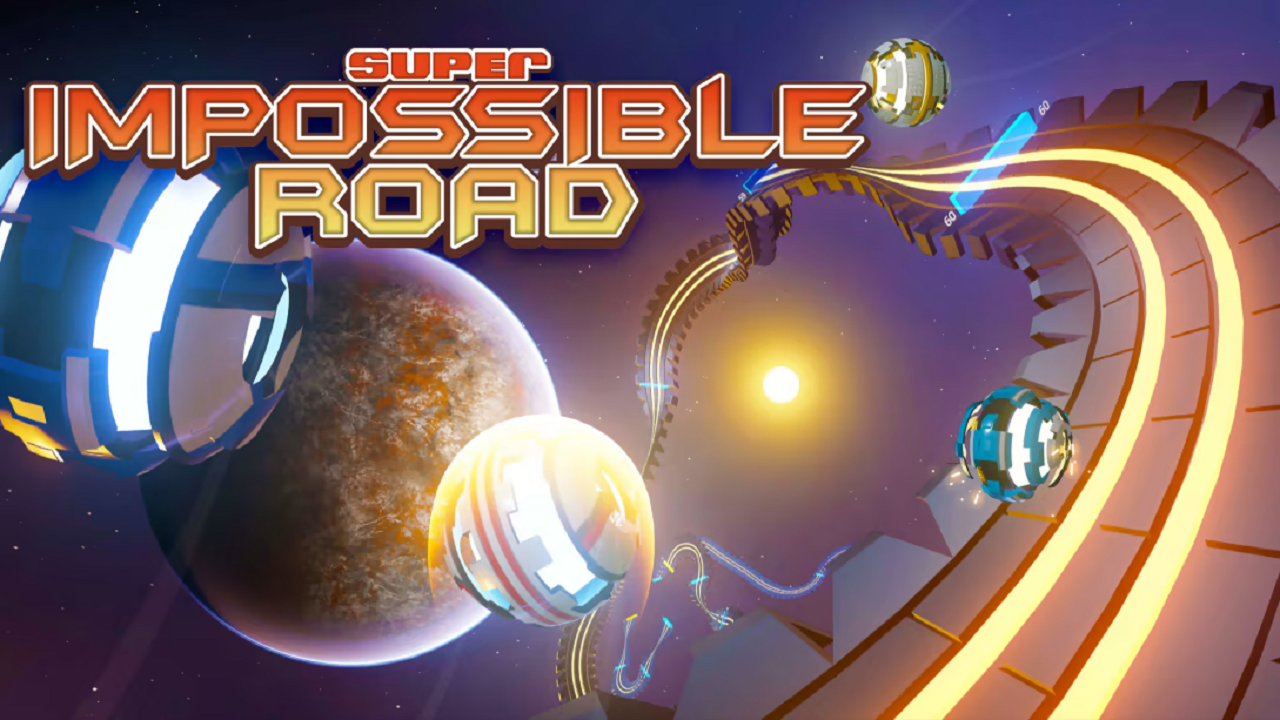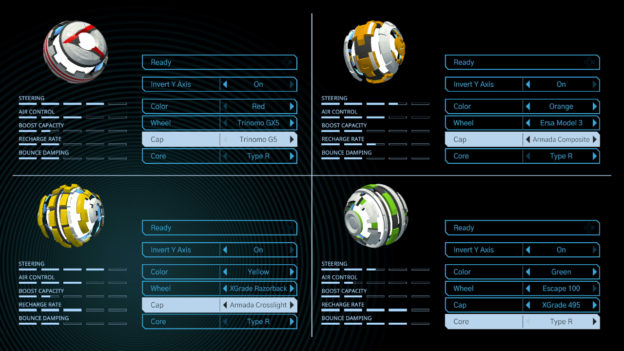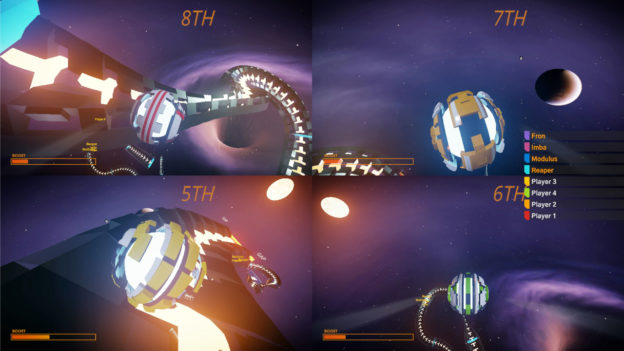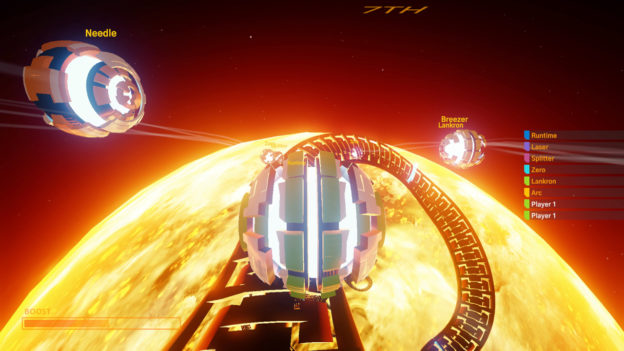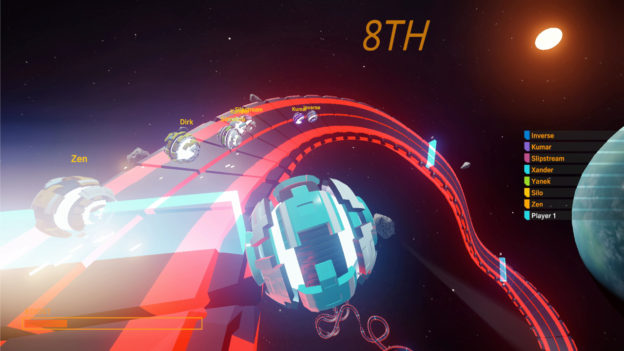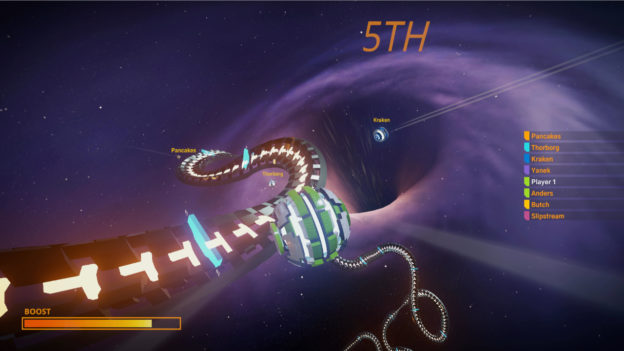Initially released in 2016, Super Impossible Road is the newest contender in the racing genre on the Switch. It’s a fast-paced, futuristic racer where you control a ball on what is essentially a roller coaster track. And while it’s undoubtedly a beautiful game with a lot of ambition, it lacks essential elements to place it on the medal podium.
There’s no denying that Super Impossible Road is gorgeous and a technical feat. The game is fast, and the Switch handles the performance quite well. The best way to describe Super Impossible Road is rolling a marble along a roller coaster track with no guardrails, which allows you to make jumps off the track and (hopefully) land farther down the path. In fact, the game encourages you to cheat, and in some cases, you won’t win races if you don’t. Each track is a procedurally generated road that is a downward spiral to the finish line. There are no brakes or sliding mechanics; the only additional feature is a boost, which you fill as you pass through gates on the track.
Quite a bit of love and ambition went into designing Super Impossible Road, with the meat of the game found in the career mode. Career mode is where you learn most of the gameplay mechanics. Some of the challenges have you race against the AI, while others have you beat the clock, jump through a certain number of rings, or skip a designated number of gates by jumping off the track. You have about three or four seconds to be off the track at any given time. If you don’t land back on the path in that time frame, you warp back to the last gate you went through. And if you skipped quite a few gates, you may be sent way back. Each challenge has a three-star achievement system, with various requirements needed to meet each achievement and three stars being the most difficult.
You have a few customizable options for your racing ball, all of which unlock from the start. Changing the options will affect the stats of the ball. For example, some options provide better steering but may affect the ability to control the ball while in the air. Changing the options allows you to customize the ball to fit your style of play.
The game also boasts a daily challenge with a leaderboard, online races, local races, and an endless mode. Unfortunately, online racing is pretty much non-existent as the lobby is empty. However, you can create a private room and invite your friends to play, which is a feature I appreciate. And while online races are dead, there are plenty of people playing the daily challenges.
As I mentioned, cheating is encouraged, allowing you to jump off the track and land farther down the path, ahead of your opponents. The problem is that I never felt I had a good sense of when I should jump off the track. This trick works in games like Mario Kart because there are designated places where you can jump off the track and get ahead. And it takes skill to pull this off in Mario Kart. So when I did pull off a cheat in Super Impossible Road, I never felt it was because of my skill; it was pure dumb luck. The farther I went in the career mode, the more complex the challenges were, and the only way to pass was to pull off these jumps of blind faith. And because Super Impossible Road lacks any other features like braking or sliding, I never felt like I was in control of my ball. So there’s nothing to work towards to get better at racing. Most times, I just jumped off the track and prayed. Thrilling for sure, but not something that I felt particularly proud of when I did pull off a win. After completing a race, I had no desire to return to see if I could get a better score.
While the idea of running down roller-coaster-type tracks is exciting, it gets old. None of the tracks feel different. Sure the backgrounds change (and some of the space-themed backgrounds are well done), however the races themselves all feel the same, outside the various challenges.
Super Impossible Road is beautiful, and a lot of passion went into creating it. The fact that there’s a career mode, online races, and daily challenges are testaments to the development team’s desire to provide an experience that will encourage players to return regularly. Unfortunately, the rest of the game misses the mark.
Review: Super Impossible Road (Nintendo Switch)
Okay
While the races are thrilling, the lack of any features found in other racers, such as sliding or braking, prevents you from building skills to master the game. Most times, it feels like you win on sheer luck. Coupled with the fact that the tracks all feel relatively the same, the experience gets stale fairly quickly.

